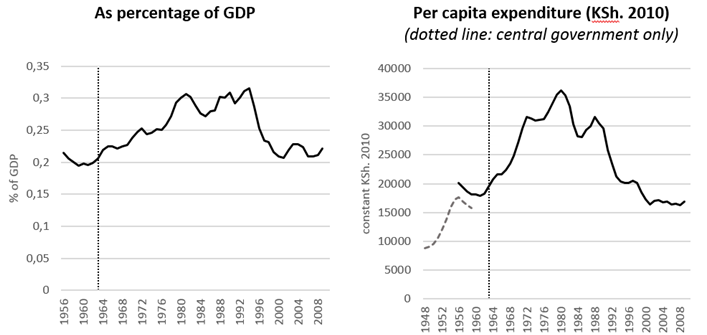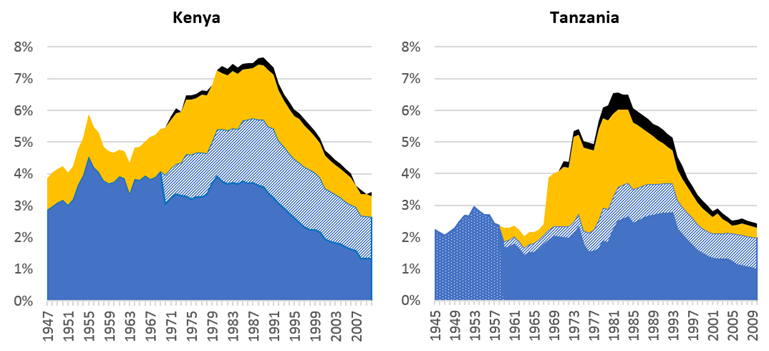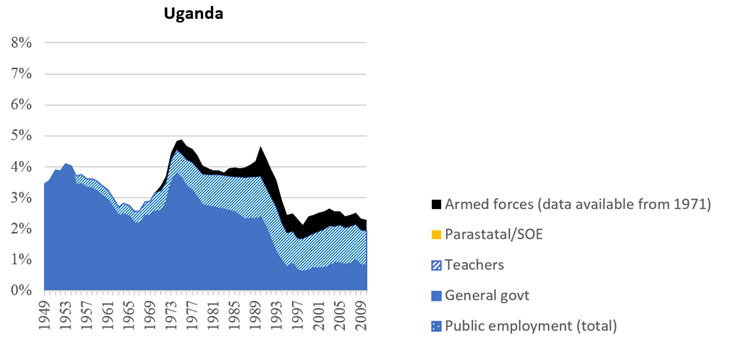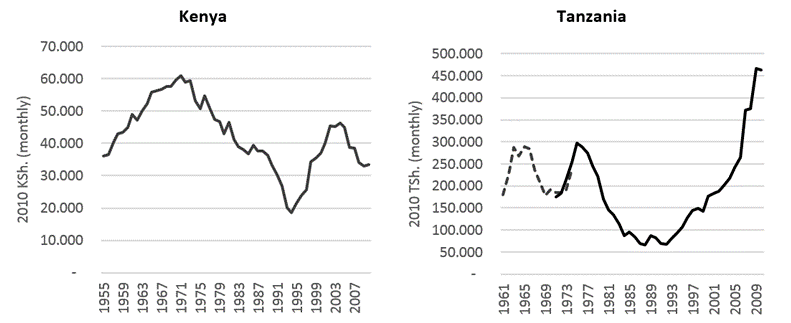One of the proximate causes of Africa’s poor growth performance – so the argument goes – is a government budget that favours patronage over growth-enhancing investments. African governments are thought to be particularly prone to excessive spending on staffing, as public sector jobs provide an important means of shoring up political support in weak and ethnically fragmented states (Easterly and Levine 1997, Englebert 2000, Acemoglu and Robinson 2010).
New Data on Public Employment and Expenditure Trends
Yet the evidence underpinning such theories is far from overwhelming, and some cross-sectional studies have questioned whether African states were ever in fact all that bloated (Goldsmith 1999, Mkandawire 2015). But to better understand the allocative choices made by postcolonial governments, it is valuable to consider not only their relative performance, but also how priorities and constraints shifted over time. In a recent article (Simson 2018), I therefore assembled new time series data for three East African countries that are often described as patronage-afflicted: Kenya, Tanzania and Uganda. With data collected from hundreds of national statistical publications and reports available in the recently digitized IMF and World Bank online archives, I assembled data series on public expenditure composition and employment from the 1950s to the present.
This bird’s-eye perspective allows us to debate an important counterfactual: would a more developmental allocation of public expenditure, particularly one that did not involve ‘excessive’ spending on unproductive public sector employees, have led to a better postcolonial growth performance in East Africa? I present four common trends across the three countries that complicate a simple causal story linking patronage to poor allocative efficiency and weak growth.
Expenditure and Employment Performance: Four Common Findings
Firstly, this perspective brings the expenditure collapse of the 1980s through early 1990s into sharp relief. Because of the violent terms of trade shocks, expenditure to GDP ratios understate the magnitude of expenditure decline. On a per capita basis (deflated by the CPI), public expenditure fell by more than half in Kenya and Tanzania and by a factor of six in Uganda (see example from Kenya in Figure 1). Against such a large fiscal shock, it is hard to imagine a counterfactual world where the investment levels of the 1960s were maintained or increased.
Figure 1: Kenya: General Government Expenditure, 1950s-2010

Secondly, contrary to common perception, post-independence budgets did not prioritize wage budget growth. In the immediate independence period governments sought to increase spending on ‘development’, primarily through support for infrastructure and the nationalization of industry, and very much in accordance with the development theories of the day. In the 1970s military spending started escalating, particularly in Uganda and Tanzania as civil and regional conflict escalated. In the 1980s the debt-financed development budget came back to haunt, as foreign-denominated debt service payments escalated against a depreciating currency. Against these pressures on the budget, wage expenditure fell as a share of total spending in Kenya and Uganda and remained flat in Tanzania.
Third, as Figure 2 shows public employment (relative to the labour force) grew in the first two decades of independence, peaking in the 1980s, but then fell just as precipitously during the structural adjustment era. Some of this rise and decline was due to the creation and dismantling of a parastatal sector. But there was also a considerable increase in the employment of frontline service providers, particularly teachers. Consequently, jobs increasingly shifted out of the capital cities and the regional distribution of employment improved.
Figure 2: Public sector employment as % of the labour force, by main broad sector


Fourth, this increase in employment was partly achieved at the expense of wage levels. As employment increased and the value of real expenditure declined, public sector salaries failed to keep pace with inflation. These wage declines were dramatic. In constant terms, average public sector earnings fell by roughly 70%-90% between peak and trough in the early 1990s across the three countries. In the course of the structural adjustment reforms and decline in public employment, earnings began to recover.
Figure 3: Average public sector earnings

Note: Average government wage in Tanzania.
In light of these constraints, it is hard to imagine that a leaner wage budget could have meaningfully changed the rate of economic growth in the face of bigger forces at play: terms of trade decline, debt service crises and wars. In fact, the dramatic declines in real wages from the 1970s-90s, which lowered worker morale and discipline, were perhaps the bigger policy misstep.
References
Acemoglu, D. and Robinson, J. A. (2010). ‘Why is Africa poor?’, Economic History of Developing Regions, 25(1):21–50.
Easterly, W. and Levine, R. (1997). ‘Africa’s growth tragedy: policies and ethnic divisions’, Quarterly Journal of Economics 112(4): 1203–50.
Englebert, P. (2000). ‘Pre-colonial institutions, post-colonial states, and economic development in tropical Africa’, Political Research Quarterly 53(1): 7–36.
Goldsmith, A. A. (1996). ‘Africa’s overgrown state reconsidered: bureaucracy and economic growth’, World Politics, 51(4): 520–46.
Mkandawire, T. (2015). ‘Neopatrimonialism and the political economy of economic performance in Africa: critical reflections’, World Politics 67 (3): 563–612.
Simson, R. (2018). ‘Africa’s clientelist budget policies revisited: public expenditure and employment in Kenya, Tanzania and Uganda, 1960-2010,’ Economic History Review, forthcoming.
Feature image: From Tanzania, National Archives, London, CO 1069-157-99
